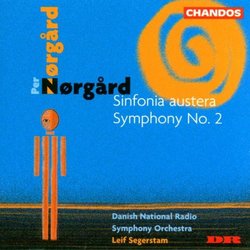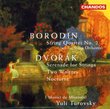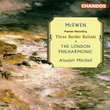| All Artists: Per Norgard, Leif Segerstam, Danish National Symphony Orchestra, Danmarks Radiosymfoniorkester Title: Per N�rg�rd: Sinfonia austera; Symphony No. 2 Members Wishing: 2 Total Copies: 0 Label: Chandos Release Date: 5/21/1996 Genre: Classical Styles: Historical Periods, Modern, 20th, & 21st Century, Symphonies Number of Discs: 1 SwapaCD Credits: 1 UPC: 095115945025 |
Search - Per Norgard, Leif Segerstam, Danish National Symphony Orchestra :: Per N�rg�rd: Sinfonia austera; Symphony No. 2
 | Per Norgard, Leif Segerstam, Danish National Symphony Orchestra Per N�rg�rd: Sinfonia austera; Symphony No. 2 Genre: Classical
Nørgård (b. 1932) is one of the most important composers to come out of the Scandinavian countries since Nielsen and Sibelius. He uses many of the same strategies they did, including reliance on folk song mater... more » |
Larger Image |
CD DetailsSynopsis
Amazon.com Nørgård (b. 1932) is one of the most important composers to come out of the Scandinavian countries since Nielsen and Sibelius. He uses many of the same strategies they did, including reliance on folk song material, but he also applies some of the tools of Modernism, which they eschewed. His Sinfonia austera (1955) is a quasi-tonal work of harsh atmospherics that never quite loses touch with a Romantic core. His Symphony 2 (1970) incorporates many of the same atmospherics as the Sinfonia austera, but it's a sound world all its own. This is part of an excellent, highly recommended series from Chandos. -- Paul Cook Similar CDs
|
CD ReviewsNordic Nature-poetry at its best 08/01/2000 (5 out of 5 stars) "Norgard's 1st symphony (Austera) is not only interesting as an example of where he originally came from compositionally. It is also an extraordinarily impressive composition in its own right. It is Austere not so much in the sense that it is either epigrammatic or sparely scored. Its austerity is more to do with the stern and hard-edged character of much of the music, which inhabits a world full of natural sounds and events, but entirely without humans. Think of Sibelius or Nielsen at their darkest, and you might get some idea of the work's predominant tone - one common to many Nordic composers. Also present are the beginnings of Norgard's very individual and distinctive mature style: a certain organic fluidity to the rhythmic and harmonic flow, and a gift for creating musical mechanisms that appear to be neither mechanistic nor organic, but a strange combination of the two. In contrast, the Second symphony in some ways shows Norgard at his most radical. But don't be afraid - the work is actually also one of his most accessible and beguiling creations. The entire work springs from a single 'infinity series' - a technical invention of Norgard's which produces an endless stream of gradually rotating and transforming figures. The effect of this is hypnotic, as if one is watching a multifacteted crystal slowly rotating in space. This is enhanced by the scoring, with bells and other tuned percussion creating a gamelan-like effect. Even after repeated listenings, the magic of this wonderfully simple and yet marvellously sophisticated music never becomes less. I recommend it wholeheartedly. Performances are terrific, and the Chandos sound is ideal - rich and spacious." Norgard's lesser two symphonies, but still good listening Christopher Culver | 06/28/2006 (4 out of 5 stars) "This Chandos CD is the first in its series of Per Norgard's symphonies performed by the Danish Radio Symphony Orchestra conducted by Leif Segerstam. Neither the "Sinfonia Austera", the Danish composer's first try at the genre, nor the Symphony No. 2 are the most impressive of Norgard's six symphonies to date, but they are nonetheless worth hearing. Not only are they important in understanding the composer's overall development, but they help one grasp other works, as I shall clarify below.
Norgard wrote "Sinfonia Austera" (1955-1956) at the age of 22, yet this is by no means juvenalia. During this time, the composer was interested in typical "Nordic" features, i.e. the soundworld of Vagn Holmboe, Hilding Rosenberg, and Jean Sibelius and the "klang" tone that was paramount in their style. While much of the symphony looks back--there's even a direct reference to Sibelius' "Tapiola"--Norgard introduces his own innovations. Motivic material is distributed among instrumental groups for maximum diversity of timbre, tonality is quite free for Nordic music, and there's a sense of space and an occasional violence about the music that explains Norgard's reputation as a budding young modernist. In spite of all this, I rarely return to the work because it pales next to the incredible theoretical breakthroughs of his later symphonies, such as the infinity series processes of the second and third, and the schizoid Wolfli style of the fourth. However, a familiarity with "Sinfonia Austera" is vital towards understanding Norgard's mysterious and highly autobiographical fifth symphony, which alludes to "Sinfonia Austera" in its dramatic conclusion. Through the 1960s Norgard experimented with his "infinity series", a method of serializing melody that has fractal-like properties of self-similiarity and unending richness to explore packed into a simple course of events. For most of the decade, the infinity series was only one tool in Norgard's toolbox, but in "Voyage Into the Golden Screen" for chamber ensemble (1968), he used it to shape all facets of a work. Knowing something about "Voyage" is very helpful to understanding the infinity series works in general. In the second movement, a given melody is played by the flutes in what can be called "normal time", while the oboes play every fourth note, the trumpets every 64th note, and tubular bells, trombones, and piano every 256th note, and so on for 1024 notes. All music is generated from one simple process. The "Symphony No. 2" (1970) can fairly be described as an expansion of "Voyage", playing 4,096 notes of the infinity series with the instrumentation of a symphony orchestra. But it's much more than that, since while "Voyage" was entirely automatic, the symphony contains a clear development. Before the series is introduced, divided among the instruments, one single note begins the work and all proceeds from it. Then, every 1,024 notes of the series, the trumpets interrupt in a striking fashion. All this gives a sense of growth before the symphony fades out at the end. All in all, however, the symphony is somewhat limited and impersonal. Norgard hadn't yet thought up harmonic and rhythmic analogues to the melodic infinity series, which came to be the natural overtone series and the golden section respectively. These three were united in his glorious third symphony of 1975, which many consider his masterpiece. The second symphony, then, hovers between two worlds, being either "Voyage" enlarged or the third symphony in miniature. If you are a fan of Norgard, and everyone very well should be, you'll want this disc. For an introduction to the great Danish composer's work, however, I'd recommend the Da Capo disc "Borderlines"-"Dream Play"-"Voyage Into the Golden Screen" or the Chandos disc "Symphony No. 3"-"Concerto in due tempi"." |

 Track Listings (4) - Disc #1
Track Listings (4) - Disc #1

